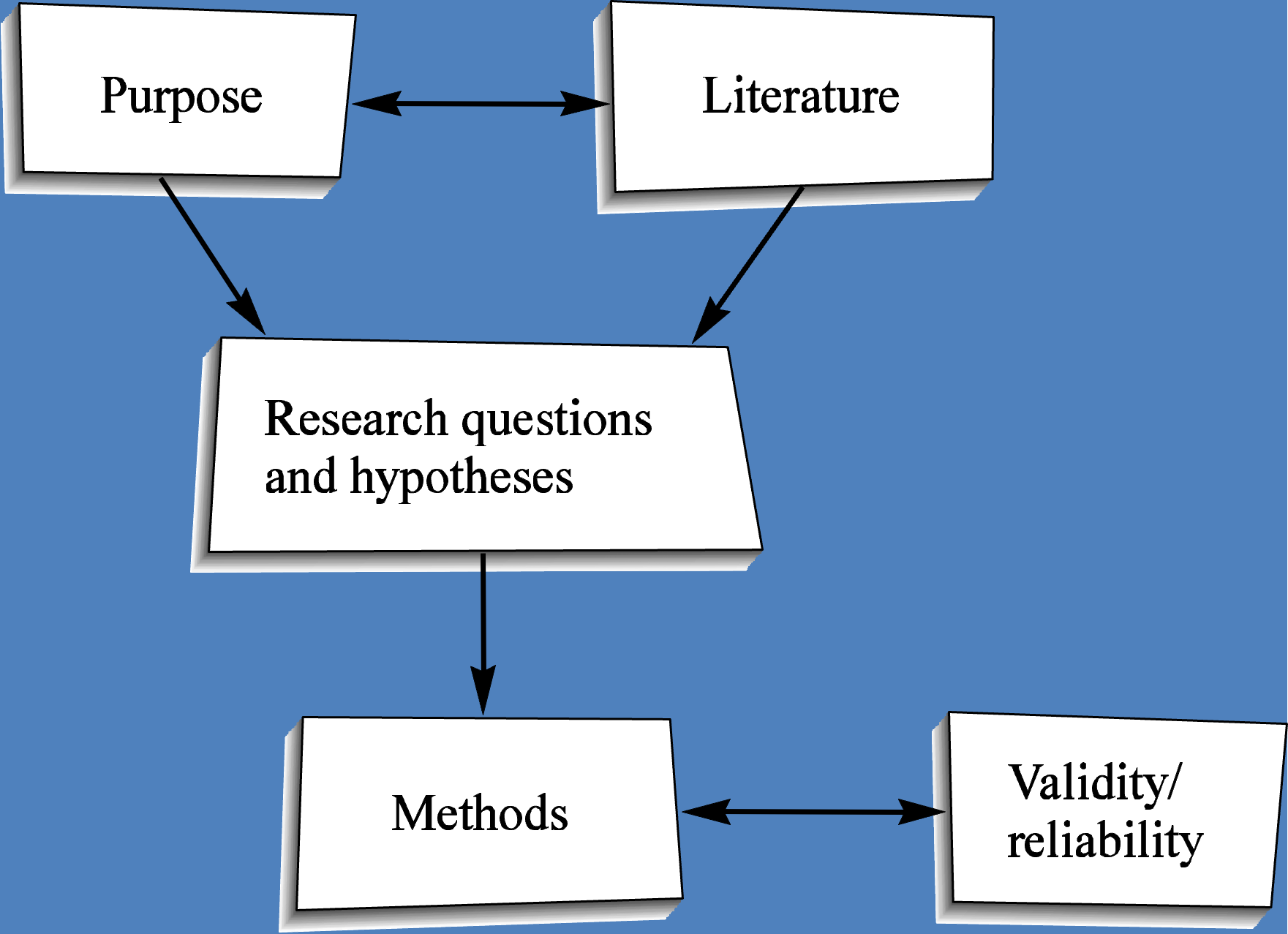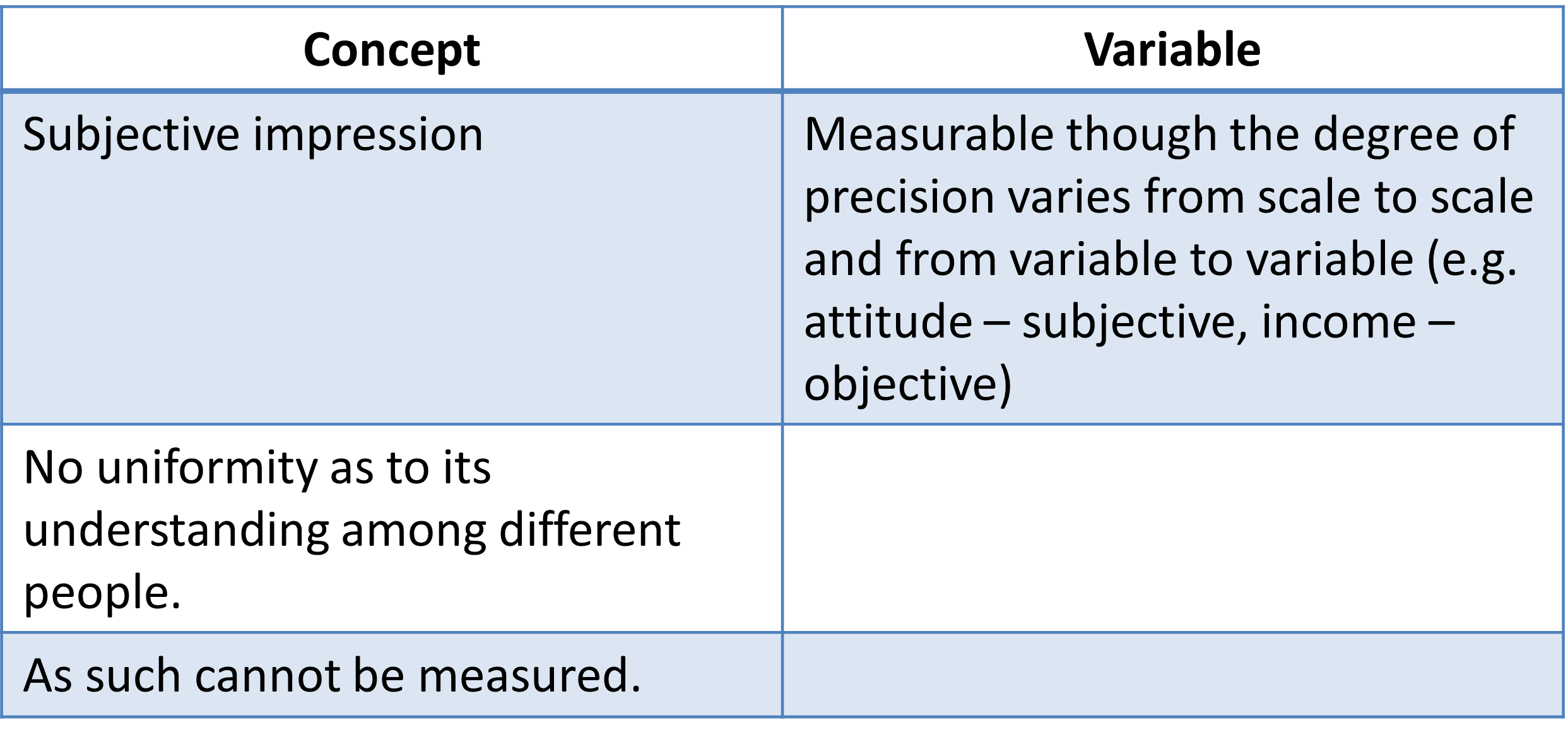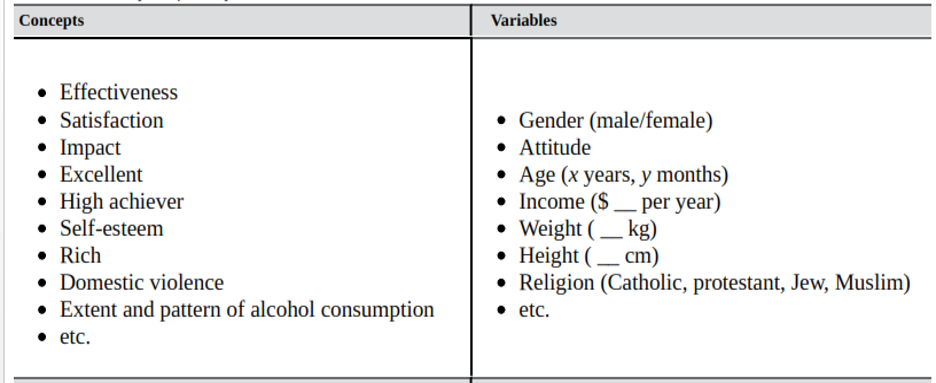Research Method: Quantitative
- What is Quantitative Research?
- Model for Conceptualizing Quantitative Research
- Purpose of Quantitative Research
- Key Components of Quantitative Research
- Research Hypotheses for Quantitative Research
- Research Questions in Quantitative Research
- Defining and Identifying Variables
- Types of Variables
- Validity of Quantitative Research
What is Quantitative Research?
Quantitative research is a type of empirical research that uses numbers and statistics to express its findings. It relies on statistical analyses and numerical measurements of specific aspects of a phenomenon under study. The key characteristic that distinguishes quantitative research from other types of empirical research is its use of numbers and statistical analyses.
In quantitative research, data is collected in the form of numbers and statistics. The quantity, amount, intensity or frequency of something is measured.
- Unit of analysis
- Amounts
- Frequencies
- Degrees
- Values
- Intensity
Common ways of collecting quantitative data include surveys, polls, questionnaires and empirical observations that yield statistical data. The data is then analyzed using statistical techniques in order to reveal patterns, averages, correlations and other statistical relationships between variables.
Quantitative research is based on testing a theory composed of variables that are measured with numbers and analyzed with statistics in order to determine if the theory explains or predicts a phenomenon of interest. The variables used in quantitative research are carefully operationalized to ensure they can be measured, typically on instruments with numeric scales. The purpose of measurement in quantitative research is to be able to generalize findings from a smaller group to a larger population.
Some of the key characteristics of quantitative research include:
- Uses numbers and statistics to express findings
- Involves measurements and amounts of things
- Employs mathematical analysis and statistical inferences
- Tests or verifies theories or hypotheses
- Allows generalizations to be made from a sample to a population
- Uses controlled experiments, surveys and questionnaires
- Uses deductive reasoning to arrive at conclusions
- Seeks precise measurement and quantification of data
- Uses structured and predetermined approaches
- Provides quantifiable predictions and explanations
Model for Conceptualizing Quantitative Research
- Overall purpose or objective
- Research literature
- Research questions and hypotheses
- Selecting appropriate methods
- Validity and reliability of the data

Purpose of Quantitative Research
Exploratory
Exploratory quantitative research is a good starting point to get familiarized with some insights and ideas around a topic. For example, exploratory research can help identify key variables that may be involved in a phenomenon, like the dependent and independent variables in a causal relationship. Exploratory research helps set the stage for future research.
Descriptive
Descriptive quantitative research focuses on “mapping out” the details of a circumstance, situation, event, or population. Descriptive research aims to provide a complete and accurate description by measuring and reporting on the characteristics of variables within a particular sample. For example, a descriptive study could measure average household income in a city to describe the economic landscape.
Causal
Causal quantitative research seeks to determine cause-and-effect relationships between variables through experimentation and statistical analysis. Causal studies test whether changes in an independent variable actually produce changes in a specified dependent variable. For instance, an experiment could test whether a new educational program (independent variable) improves student test scores (dependent variable). Causal research assesses the impact or objectives of a program or intervention.
Key Components of Quantitative Research
Quantitative research relies on key components to build a solid foundation before collecting data. These components include:
Concepts
A concept is an abstract idea that is used to classify or categorize a phenomenon. Concepts help distinguish one phenomenon from another. For example, the concepts of motivation, stress, and depression can be used to classify psychological states.
Constructs
A construct is the conceptual definition or meaning of a concept. Constructs are theoretical and must be observable or measurable. Constructs link concepts together. For example, the construct of self-esteem may be defined as “an individual’s subjective evaluation of their own worth.” This links to concepts like self-image, self-perception, confidence, etc.
Variables
Variables are presented in research questions and hypotheses. A variable is a characteristic or property that varies across people or situations. Variables can be actions, values, attributes, attitudes, beliefs, etc. Independent variables are presumed causes. Dependent variables are presumed effects. For example, income (independent variable) and life satisfaction (dependent variable).
Operationalization
Operationalization is the process of defining how a variable will be measured or observed in the study. This makes an abstract concept concrete. For example, income level could be operationalized by having participants select a range that matches their annual household income. Operationalization ensures valid, reliable measurement of variables.
Research Hypotheses for Quantitative Research
Research hypotheses are educated guesses or predictions that the researcher makes about the expected relationships between variables in a study. They are formal statements that clearly describe the expected outcomes of the study.
Research Questions in Quantitative Research
Research questions are preferred over hypotheses when:
- Little is known about a communication phenomenon
- Previous studies report conflicting results
- The goal is to describe communication phenomena
Research questions are used to describe and explore, while hypotheses predict. With research questions, the researcher is interested in discovering, describing or mapping aspects of a certain phenomenon. The purpose is exploratory and descriptive.
On the other hand, hypotheses propose a relationship between variables and predict an expected outcome. Hypotheses are based on an extensive review of previous research and theory. The purpose of a hypothesis is explanation and prediction.
Defining and Identifying Variables
What is a Variable?
A variable is a concept that can be measured. It is a property that takes on different values. A variable is something that varies. A variable is a symbol to which numerals or values are attached. Variables are rational units of analysis that can assume any one of a number of designated sets of values.
The main difference between a concept and a variable is measurability. A variable must be observable or measurable.


Types of Variables
There are several ways to categorize the different types of variables:
Variables Based on Causal Relationship
- Independent variable: The cause that is responsible for bringing about changes in a phenomenon or situation.
- Dependent variable: The outcome or changes that are brought about by the introduction of an independent variable.
- Extraneous variable: Other factors operating in a real-life situation that may affect changes in the dependent variable.
- Intervening variable: Links the independent and dependent variables. The relationship between an independent and dependent variable cannot be established without the intervention of this variable.
Example of Variable Based on Causal Relationship


Variables Based on Study Design
- Active variables: Variables that can be manipulated, changed or controlled.
- Attribute variables: Variables that cannot be manipulated, changed or controlled, and reflect characteristics of the study population (e.g. age, gender).
Variables Based on Unit of Measurement
- Constant variable: Has only one category or value (e.g. taxi, tree, water).
- Dichotomous variable: Has only two categories (e.g. yes/no, male/female).
- Polytomous variable: Can be divided into more than two categories (e.g. religion, political parties, attitudes).
Validity of Quantitative Research
Validity refers to how well a test measures what it claims to measure. It is vital for a research study to be valid in order for the results to be accurately applied and interpreted. There are four main types of validity to consider in quantitative research:
Construct Validity
Construct validity examines whether the measures used are actually measuring what they are intended to measure. It looks at whether the operational definition of a variable accurately reflects its theoretical meaning. Strong construct validity means the variable is defined and measured correctly in relation to the concepts being studied.
Internal Validity
Internal validity examines whether changes in the dependent variable are actually caused by changes in the independent variable, rather than being caused by confounding variables. It questions if there is a causal relationship between the independent and dependent variables. High internal validity allows the researcher to make definitive statements about cause-and-effect relationships.
External Validity
External validity considers whether results can be generalized beyond the specific study to wider populations, settings, time periods, and measures. It questions if findings are externally valid and applicable to other contexts. High external validity allows the results to be applicable in a wide variety of contexts.
Statistical Validity
Statistical validity examines the appropriateness of statistical tests used, accuracy of analysis, and statistical power of the study. It looks at whether enough data is collected to support statistically valid conclusions. High statistical validity means appropriate tests are used and there is enough statistical power to avoid errors.